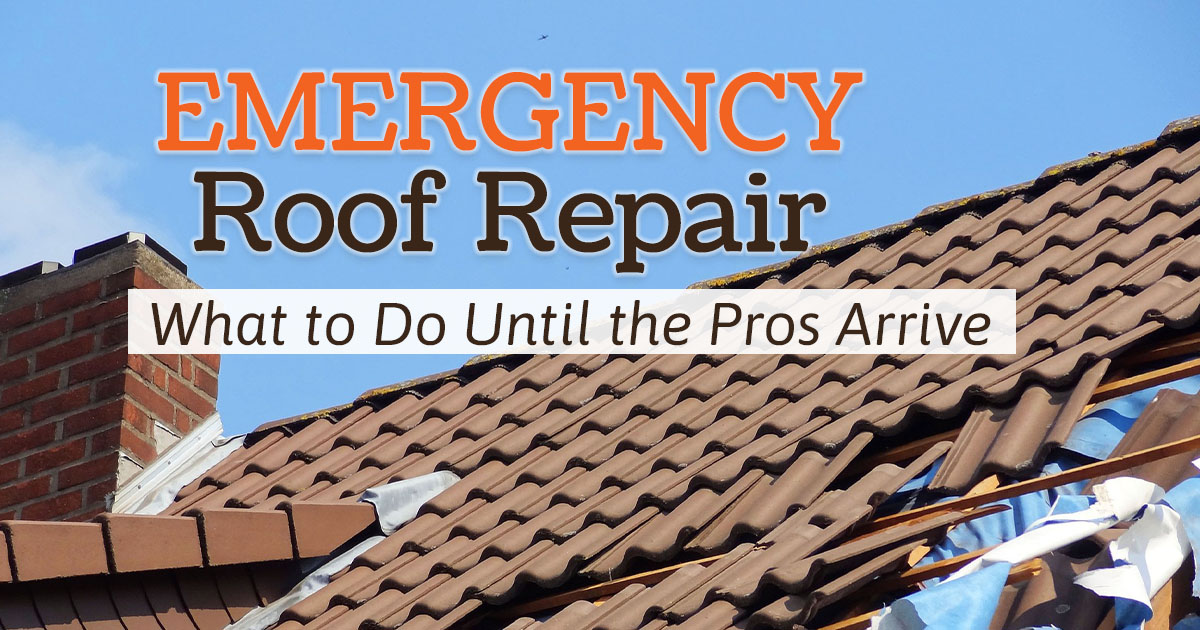Emergency Roof Repair: What to Do Until the Pros Arrive
Published: 11/24/23

When faced with the unexpected need for emergency roof repair until the pros arrive, swift and informed action is your best ally. Roofing emergencies can strike without warning, often during inclement weather or at night, leaving homeowners scrambling. So, let’s get into the essential steps and temporary measures to safeguard your property while awaiting professional assistance!
Safety first
Safety should be your top priority when dealing with emergency roof repairs. You can rely on roofing professionals later, but it's important to safeguard your health in the present. Before you even think about assessing or repairing anything, ensure that you and anyone helping you wear appropriate safety gear, including sturdy gloves, non-slip shoes, and safety glasses. Staying aware of potential hazards, such as loose debris, slippery surfaces, or electrical wires is crucial. After all, a few extra moments spent on safety measures can prevent injuries and ensure you're in the best condition to handle the situation until the professionals arrive.
Assessing the damage
Assessing the damage to your home is the crucial first step in emergency roof repair. Start by carefully surveying the extent of the damage, taking note of any visible issues like missing shingles, leaks, or sagging areas. This visual inspection will help you understand the scope of the problem.
Document the damage through photographs or notes, as this documentation can be invaluable when dealing with insurance claims later. Additionally, consider the type of damage you're dealing with. For instance, if it’s a leak, it may require different immediate actions compared to structural issues. So, a thorough assessment is the foundation for effective temporary repairs and ensures you can communicate the situation clearly to professionals when they arrive.
Temporary leak mitigation
Temporary leak mitigation is an important step when faced with a roof emergency. When you notice a leak, the first thing to do is locate the source of the problem. Once identified, use materials at hand like buckets, towels, or tarps to control and contain the water ingress.
Placing a bucket under the leak can catch dripping water, preventing it from damaging your interior. Towels or rags can also help soak excess moisture in the affected area. In cases of larger leaks or where water spreads, carefully position a tarp over the damaged section. Secure the tarp tightly to prevent wind damage and ensure it directs water away from your home.
Remove debris and blockages
Removing debris and blockages from your roof is essential. Start by carefully clearing leaves, branches, and other debris. That helps prevent further damage and allows you to assess the situation more accurately. Gutters and downspouts very much deserve special attention, too. Blockages in these areas can lead to water pooling on your home, increasing the risk of leaks and structural damage.
So, use a ladder and gloves to clear any obstructions in your gutters. Regularly maintaining your gutters can prevent future problems caused by blockages, too. Of course, if the damage is severe, especially if you're dealing with something like a tree falling on your roof, it’s better just to evacuate and wait.
Secure loose shingles
Securing loose shingles is a critical step in emergency roof repair. When you notice loose or missing shingles, it's essential to act promptly. Start by identifying the affected areas, and if possible, reattach the loose shingles using roofing cement or nails. Ensure they are securely fastened to prevent wind or water from getting underneath.
If you have missing shingles, replace them with matching ones to maintain the integrity of your home. Ignoring loose or missing shingles can lead to more significant problems, such as leaks and further damage to your roof's structure. While these repairs are temporary, they can buy you time until professionals arrive to assess and address the underlying issues.
Patching small holes and cracks
Patching small holes and cracks in your roof is vital in emergency repair. When you notice these vulnerabilities, promptly addressing them can prevent further damage. Start by identifying the locations of these holes or cracks, which may be causing leaks or weakening your roof's structure. You can temporarily patch them using most hardware stores' cement or sealant. Apply the material generously to cover the damaged area, smoothing it out for a secure seal.
Tarps and temporary roof coverings
Using tarps and temporary coverings can be a lifesaver in emergencies. A tarp can provide an effective temporary solution when you're faced with substantial damage, like large holes or missing roof sections. Start by carefully positioning the tarp over the damaged area, ensuring it's secured tightly to prevent wind damage. That keeps out rain and protects your home's interior from further water intrusion. The key is to overlap the tarp sufficiently and secure it with boards or weights to hold it in place.
Managing interior damage
Managing interior damage caused by a leak or emergency is crucial for minimizing harm to your home. So, when water infiltrates your interior, it's essential to act swiftly. Begin by identifying the affected areas and moving valuable possessions away from harm's way. Placing buckets or containers under leaks can help contain water and prevent it from spreading further.
Dry out wet areas promptly to mitigate damage and prevent mold growth using fans or dehumidifiers. Remember to document the damage with photographs and notes for insurance purposes here, too. However, these are temporary fixes, and it's crucial to seek professional help to address the underlying roof issue.
Calling the professionals
Calling the professionals for your roof emergency is a vital step that should not be delayed. Just like you hire relocation pros in Bradenton when you need to relocate fast, safely, and securely in Bradenton, FL, it's just as important to call in the right roofer in a timely fashion! Experts possess the skills and equipment needed to assess the full extent of the damage accurately. They can provide a comprehensive solution to address immediate and long-term concerns. Still, when choosing a roofing professional, prioritize reliability, experience, and reputation. Never settle for a subpar service; a hasty decision can lead to inadequate repairs.
Preventative measures
Taking preventative measures to maintain your roof is essential for its longevity and your home's safety. Regular inspections and maintenance routines are doubly important if you have a solar energy setup on your roof, too, since they can be rather sensitive. Therefore, check for loose or damaged shingles and repair them promptly. Clean your gutters and downspouts to prevent blockages that can lead to water damage. Finally, trim overhanging branches to prevent them from falling onto your roof during storms. And, of course, inspect your attic for signs of leaks or moisture, as these can indicate problems.
Save yourself from bigger expenses
Being prepared for emergency roof repair until the pros arrive is an invaluable skill for homeowners. These unforeseen situations demand quick thinking and immediate action to protect your home from more harm. So, following the guidelines outlined in this guide, you can effectively manage emergencies, minimize risks, and ensure that your property remains safe and secure until professional help arrives! Your proactive approach can save you time, money, and the stress of dealing with extensive repairs.
REQUEST A
FREE ESTIMATE

See What Our Customers Are Saying
Recent Posts
Choosing A Multi-residential Roofer
Choosing The Best Roofer
Energy Efficient Roofing Solutions
How Long Does It Take To Replace A Roof?
Debunking 10 Common Roofing Myths
2025 Roofing Tech & Trends
How To Choose Color For Tile Roof
What Is Drip Edge?
What Do Roof Vents & Penetrations Do?
How Roofs Impact Market Value
Best Roof for Florida
Maximizing Energy Efficiency
Roof Inspections 2024
Prepare Your Roof For Spring
Lifespan of Different Roofing Materials
How Roof Type Affects Value
Choosing Materials for Extreme Weather
Guide to Cleaning Gutters Safely
Emergency Roof Repair: What to do until the professionals arrive
New Roof Tech: GAF Solar Energy Shingles
How to Minimize Fire Hazards on Roof
How Florida Heat Affects Roof
Top Benefits of Shingle Roofs
Solar Options for Florida Homes
What to do if Hurricane Damages Roof
2023 Hurricane Season Roof Preparation Checklist
Does Adding Solar Increase Your Home's Value?
What it takes to be a GAF Master Elite Contractor
How To Choose The Right Roof Shingles
How To Choose The Right Windows & Doors For Your Home
How To Choose Solar Energy System For Your Home
What To Do If Tree Falls On Your Roof
Residential Roof Spring Cleaning Checklist
Should You Replace Your Gutters When You Replace Your Roof?
New Homeowners' Guide To Roof
Roof Warranties
2023 Solar Energy Trends
Time To Replace Front Door
Roofs With Curb Appeal
Roof is Leaking During Storm
New Roof vs. Repair